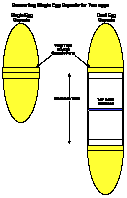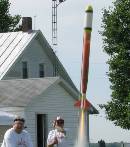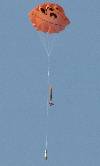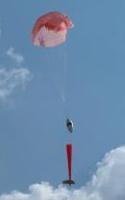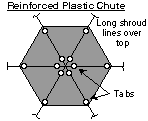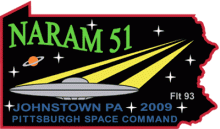 |
NARAM-51 Event Tips Pages (draft) |
 |
|
|
|
|
|
|
|
|
|
|
|
|
|
|
|
|
|
|
|
For NARAM-51, the Dual Egg Duration event is D engine class Dual Eggloft Duration combines the challenge of flying a model containing and recovering TWO Grade A Large eggs intact, with trying to stay in the air as long as possible. Sometimes doing too well, staying up so long that the model flies away, unrecoverable, or landing in an inaccessible spot (or tree). The model must stay together, nothing can separate from it other than wadding. It cannot be staged. If the eggs are not both returned or one is damaged (cracked, broken, etc.), the flight is disqualified. You can NOT catch the egglofter, it must be allowed to land naturally. For the full rules for this event, please see the Dual Eggloft Duration Rules on the NAR web page. Scoring - For Eggloft Duration only, the scoring is best SINGLE qualified flight time, returned, of two flights allowed. Design considerations - Balancing ability to store and reliably deploy a large parachute, with low model weight. An all-18mm body with a capsule on top as used for Eggloft altitude is not a good choice here since parachute storage space is very limited. An egglofter with a long tapered conical shroud is a good way to go for lower powered single Eggloft Duration, as it has a significant amount of parachute storage space. The Two Minute Egg plan is such a model, and both ASP and QCR have similar contest oriented kits. A straight body tube with a larger diameter, such as 1.3" to 1.65" diameter (BT-55, 35mm, BT-60) can be used. The model will be draggier and usually heavier, of course, and therefore at a competitive disadvantage. The Quest "Courier" egglofter kit can be used for D Eggloft. Some regular models you might already have can be adapted to fly as an eggloft duration model by replacing the nose cone with a capsule. But they cannot be too heavy or they just will not fly safely enough with the added weight of an egg. A list of plans and kits is included further down on this page. Egg Capsule - Pratt Hobbies makes an excellent vac-formed egg capsule (the old CMR capsule). Some companies like Aerospace Specialty Products (ASP) and QCR carry that capsule. Apogee also has their own vac-formed egg capsule. Pratt Hobbies also makes a Dual Egg Capsule. It is nice, but the two eggs cannot be totally isolated from each other with a bulkhead, as can be done when using an extension tube with a bulkhead. A good way to use the Pratt Hobbies Dual Egg Capsule would be with a SHORT extension, that had a bulkhead glued into it. Another capsule sometimes used is a plastic Easter Egg, of a size that is just a little bigger than an egg. Using two "long halves" from two 1.75" diameter Easter eggs, rather than one plastic egg due to the short half with a flange sticking out, as the flange limits the inside diameter too much. Easter Egg capsules that small can be hard for the eggs to fit in and be safely cushioned, however. "Grade A Large" eggs tend to vary significantly in diameters, so Easter Egg capsules are somewhat risky, unless you have an Easter Egg that is 2" or so in diameter. Since this is for duration, it's best not to risk using a too-cramped capsule.
WARNING - Kevlar Shock cords can eaisly be burned through by the heat of the ejection charge of a D12 engine, and may suffer the same from a D10 or D13 ejeciton. Therefore, it is better to attach a 100 pound Kevlar cord to the outside. Such as a loop around the base of the engine mount tube, and run up the side of the body tube.
|
|
Model Plans & Kits |
Designer |
Notes |
|
2-Minute
Egg Plans (NAR website) |
Plan by George Gassaway |
18mm engine model, would need a dual egg extension tube. |
|
ASP - Egglofter Kits (various) & Pratt Egg Capsules |
ASP (Aerospace Specialty Products), Andy Jackson |
Good competitive kits, may need dual egg extension tube. |
|
QCR - Egglofter Kits using "Easter Egg" & "Pratt " capsules for 18mm engines. |
QCR - Qualified Competition Rockets, Ken Brown |
Good competitive kits, may need dual egg extension tube. |
|
QUEST - "Courier" sport egglofter kit |
QUEST - Model Aerospace Company |
Fly D10 or D13 reload, or convert to a 24mm mount for D12-3 power. Available from Quest dealers, including Red Arrow and Apogee. Needs dual egg extension tube. |
|
Estes - Big Bertha |
ESTES |
Add Dual Egg Capsule, fly on D10 or D13, or convert to 24mm mount for D12-3 or D12-5 |
|
by Andy Jackson, on the ASP website |
Great article on considering what size or type of parachutes to use in egglofting competition, whether for duration or altitude. Also tips on chute packing. |
